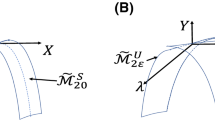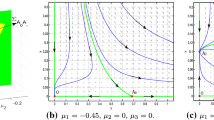Abstract
This paper investigates the qualitative structures of a discrete ratio-dependent predator–prey model near a degenerate fixed point whose eigenvalues are \(\pm 1\). By the normal form theory, Picard iteration and Takens’s theorem, this model is transformed into an ordinary differential system. Then the qualitative structures of this differential system near the highly degenerate equilibrium are analyzed with the blowing-up method, which yields the ones of the discrete model near the fixed point by the conjugacy between the discrete model and the time-one mapping of the vector field.













Similar content being viewed by others
Data Availibility Statement
The data sets generated during and/or analysed during the current study are available from the corresponding author on reasonable request.
References
Álvarez, M.J., Ferragut, A., Jarque, X.: A survey on the blow up technique. Int. J. Bifur. Chaos Appl. Sci. Eng. 21, 3103–3118 (2011)
Aulisa, E., Jang, S.R.J.: Continuous-time predator-prey systems with Allee effects in the prey. Math. Comput. Simul. 105, 1–16 (2014)
Baigent, S., Hou, Z., Elaydi, S., Balreira, E.C., Luís, R.: A global picture for the planar Ricker map: convergence to fixed points and identification of the stable/unstable manifolds. J. Differ. Equ. Appl. 29, 575–591 (2023)
Balreira, C.E., Elaydi, S., Luís, R.: Local stability implies global stability for the planar Ricker competition model. Discrete Contin. Dyn. Syst. Ser. B 19, 323–351 (2014)
Chakraborty, P., Sarkar, S., Ghosh, U.: Stability and bifurcation analysis of a discrete prey-predator model with sigmoid functional response and Allee effect. Rend. Circ. Mat. Palermo 2(70), 253–273 (2021)
Chen, Q.L., Teng, Z.D.: Codimension-two bifurcation analysis of a discrete predator-prey model with nonmonotonic functional response. J. Differ. Equ. Appl. 23, 2093–2115 (2017)
Chen, Q.L., Teng, Z.D., Wang, F.: Fold-flip and strong resonance bifurcations of a discrete-time mosquito model. Chaos, Solitons Fractals 144, 110704 (2021)
Cheng, L.F., Cao, H.J.: Bifurcation analysis of a discrete-time ratio-dependent predator-prey model with Allee effect. Commun. Nonlinear Sci. Numer. Simul. 38, 288–302 (2016)
Cheng, Q., Zhang, Y.L., Deng, S.F.: Qualitative analysis of a degenerate fixed point of a discrete predator-prey model with cooperative hunting. Math. Methods Appl. Sci. 44, 11059–11075 (2021)
Chow, S.N., Li, C., Wang, D.: Normal Forms and Bifurcation of Planar Vector Fields. Cambridge University Press, New York (1994)
Din, Q.: Dynamics and chaos control for a novel model incorporating plant quality index and larch budmoth interaction. Chaos, Solitons & Fractals 153, 111595 (2021)
Din, Q.: Complex dynamical behavior and control of a discrete ecological model. J. Vib. Control 29, 5270–5288 (2023)
Din, Q., Khan, M.I.: A discrete-time model for consumer-resource interaction with stability, bifurcation and chaos control. Qual. Theory Dyn. Syst. 20, 1–35 (2021)
Din, Q., Zulfiqar, M.A.: Qualitative behavior of a discrete predator-prey system under fear effects. Ze. Naturforsch. A 77, 1023–1043 (2022)
Dumortier, F., Rodrigues, P.R., Roussarie, R.: Germs of Diffeomorphisms in the Plane. Springer, New York (1981)
Fei, L.Z., Chen, X.W., Han, B.S.: Bifurcation analysis and hybrid control of a discrete-time predator-prey model. J. Differ. Equ. Appl. 27, 102–117 (2021)
Ishaque, W., Din, Q., Khan, K.A., Mabela, R.M.: Dynamics of predator-prey model based on fear effect with bifurcation analysis and chaos control. Qual. Theory Dyn. Syst. 23, 26 (2024)
Kulakov, M., Neverova, G., Frisman, E.: The Ricker competition model of two species: Dynamic modes and phase multistability. Mathematics 10, 1076 (2022)
Kuznetsov, Y.A.: Elements of Applied Bifurcation Theory, 3rd edn. Springer, New York (2004)
Kuznetsov, Y.A., Meijer, H.G., van Veen, L.: The fold-flip bifurcation. Int. J. Bifur. Chaos Appl. Sci. Eng. 14, 2253–2282 (2004)
Lei, C., Han, X.L., Wang, W.M.: Bifurcation analysis and chaos control of a discrete-time prey-predator model with fear factor. Math. Biosci. Eng. 19, 6659–6679 (2022)
Levi, M., Zhou, J.: Arnold tongues in area-preserving maps. Arch. Ration. Mech. Anal. 247, 32 (2023)
Li, X.Y., Liu, Y.Q.: Transcritical bifurcation and flip bifurcation of a new discrete ratio-dependent predator-prey system. Qual. Theory Dyn. Syst. 21, 122 (2022)
Liu, P., Elaydi, S.N.: Discrete competitive and cooperative models of Lotka-Volterra type. J. Comput. Anal. Appl. 3, 53–73 (2001)
Luís, R., Elaydi, S., Oliveira, H.: Stability of a Ricker-type competition model and the competitive exclusion principle. J. Biol. Dyn. 5, 636–660 (2011)
May, R.M.: Biological populations with non-overlapping generations: Stable points, stable cycles, and chaos. Science 186, 645–647 (1974)
Naik, P.A., Eskandari, Z., Avazzadeh, Z., Zu, J.: Multiple bifurcations of a discrete-time prey-predator model with mixed functional response. Int. J. Bifur. Chaos Appl. Sci. Eng. 32, 2250050 (2022)
Revel, G., Alonso, D.M., Moiola, J.L.: A gallery of oscillations in a resonant electric circuit: Hopf-Hopf and fold-flip interactions. Int. J. Bifur. Chaos Appl. Sci. Eng. 02, 481-494 (2008)
Ryals, B.: Dynamics of the degenerate 2D Ricker equation. Math. Methods Appl. Sci. 42, 553–566 (2019)
Ryals, B., Sacker, R.J.: Global stability in the 2D Ricker equation. J. Differ. Equ. Appl. 11, 1068–1081 (2015)
Ryals, B., Sacker, R.J.: Global stability in the 2D Ricker equation revisited. Discrete Contin. Dyn. Syst. Ser. B 22, 585–604 (2017)
Salman, S.M., Yousef, A.M., Elsadany, A.A.: Stability, bifurcation analysis and chaos control of a discrete predator-prey system with square root functional response. Chaos, Solitons Fractals 93, 20–31 (2016)
Smith, H.L.: Planar competitive and cooperative difference equations. J. Differ. Equ. Appl. 3, 335–357 (1998)
Shu, Q., Xie, J.L.: Stability and bifurcation analysis of discrete predator-prey model with nonlinear prey harvesting and prey refuge. Math. Methods Appl. Sci. 45, 3589–3604 (2022)
Zhang, Y.L., Cheng, Q., Deng, S.F.: Qualitative structure of a discrete predator-prey model with nonmonotonic functional response. Discrete Contin. Dyn. Syst. Ser. S 16, 773–786 (2023)
Zhang, Z.F., Ding, T.R., Huang, W.Z., Dong, Z.X.: Qualitative Theory of Differential Equations. American Mathematica Society, Providence (1992)
Zhang, X., Zhang, Q.L., Sreeram, V.: Bifurcation analysis and control of a discrete harvested prey-predator system with Beddington-DeAngelis functional response. J. Franklin Inst. 347, 1076–1096 (2010)
Zhang, J., Zhong, J.Y.: Qualitative structures of a degenerate fixed point of a Ricker competition model. J. Differ. Equ. Appl. 25, 430–454 (2019)
Zhong, J.Y., Deng, S.F.: Two codimension-two bifurcations of a second-order difference equation from macroeconomics. Discrete Contin. Dyn. Syst. Ser. B 23, 1581–1600 (2018)
Zhong, J.Y., Zhang, J.: The stability of a degenerate fixed point for Guzowska-Luís-Elaydi model. J. Differ. Equ. Appl. 24, 409–424 (2018)
Zhuo, X.L., Zhang, F.X.: Stability for a new discrete ratio-dependent predator-prey system. Qual. Theory Dyn. Syst. 17, 189–202 (2018)
Acknowledgements
The authors would like to thank the referees for their valuable comments and suggestions. This research is supported by the National Natural Science Foundation of China (12171171), the Natural Science Foundation of Fujian Province of China (2022J01303 and 2023J01121) and the Scientific Research Funds of Huaqiao University.
Author information
Authors and Affiliations
Contributions
S.D. proposed the idea of this paper and performed all the steps of the proofs. J. Y. wrote the whole paper. All authors read and approved the final manuscript.
Corresponding author
Ethics declarations
Conflict of interest
This work does not have any Conflict of interest.
Additional information
Publisher's Note
Springer Nature remains neutral with regard to jurisdictional claims in published maps and institutional affiliations.
Rights and permissions
Springer Nature or its licensor (e.g. a society or other partner) holds exclusive rights to this article under a publishing agreement with the author(s) or other rightsholder(s); author self-archiving of the accepted manuscript version of this article is solely governed by the terms of such publishing agreement and applicable law.
About this article
Cite this article
Yang, J., Deng, S. Qualitative Structures Near a Degenerate Fixed Point of a Discrete Ratio-Dependent Predator–Prey System. Qual. Theory Dyn. Syst. 23, 191 (2024). https://doi.org/10.1007/s12346-024-01052-6
Received:
Accepted:
Published:
DOI: https://doi.org/10.1007/s12346-024-01052-6




